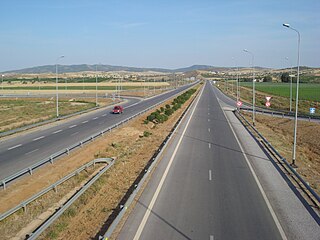See also
Lists of schools in Africa by country | |
|---|---|
| Sovereign states |
|
States with limited recognition | |
Dependencies and other territories |
|
This is a list of notable schools in the African country of Tunisia.
Primary schools and secondary schools in Tunisia include:

Tunisia, officially the Republic of Tunisia, is the northernmost country in Africa. It is a part of the Maghreb region of North Africa, bordered by Algeria to the west and southwest, Libya to the southeast, and the Mediterranean Sea to the north and east. It features the archaeological sites of Carthage dating back to the 9th century BC, as well as the Great Mosque of Kairouan. Known for its ancient architecture, souks and blue coasts, it covers 163,610 km2 (63,170 sq mi), and has a population of 12.1 million. It contains the eastern end of the Atlas Mountains and the northern reaches of the Sahara desert; much of its remaining territory is arable land. Its 1,300 km (810 mi) of coastline include the African conjunction of the western and eastern parts of the Mediterranean Basin. Tunisia is home to Africa's northernmost point, Cape Angela; and its capital and largest city is Tunis, which is located on its northeastern coast, and lends the country its name.

Tunisia has a number of international airports to service its sizable tourist trade. Tunis is the center of the transport system as the largest city having the largest port and a light transit system.

Tunis is the capital and largest city of Tunisia. The greater metropolitan area of Tunis, often referred to as "Grand Tunis", has about 2,700,000 inhabitants. As of 2020, it is the third-largest city in the Maghreb region and the eleventh-largest in the Arab world.
Société Tunisienne de l'Air, or Tunisair is the national airline of Tunisia. Formed in 1948, it operates scheduled international services to four continents. Its main base is Tunis–Carthage International Airport. The airline's head office is in Tunis, near Tunis Airport.

Gabès, also spelled Cabès, Cabes, Kabes, Gabbs and Gaps, is the capital city of the Gabès Governorate in Tunisia. It is located on the coast of the Gulf of Gabès. With a population of 152,921, Gabès is the 6th largest Tunisian city. Gabes is 327 km away from Tunis and 113 km away from Sfax.

Gafsa, originally called Capsa in Latin, is the capital of Gafsa Governorate of Tunisia. It lends its Latin name to the Mesolithic Capsian culture. With a population of 111,170, Gafsa is the ninth-largest Tunisian city and it is 335 kilometers from the capital Tunis.

The Carthage Film Festival (CFF) is an annual film festival that takes place in Tunis and founded in 1966. It is also called by its abbreviation JCC, from its French name, Journées cinématographiques de Carthage, or by its Arabic title, أيام قرطاج السينمائية. Initially biennial alternating with the Carthage Theatre Festival, the festival became an annual event in 2014. A directing committee chaired by the Tunisian Ministry of Culture, joined with professionals of the cinema industry, is in charge of the organization.

La Marsa is a coastal town in far north eastern Tunisia near the capital Tunis. The population is estimated as 92,987, as of 2014. The old summer capital of pre-colonial Tunisia, it is today a popular vacation spot for many wealthy Tunisians. It is connected to Tunis by the TGM railway. Gammarth is adjacent to El Marsa further up the coast.

The following outline is provided as an overview of and topical guide to Tunisia:

Tourism in Tunisia is an industry that generates around 9.4 million arrivals per year in 2016, 2017, 2018, 2019 & 2020, which makes it one of the most visited countries in Africa. Tunisia has been an attractive destination for tourists since the beginning of the 1960s.
Tunisia, officially the Tunisian Republic, is the northernmost country in Africa. It is a Maghreb country and is bordered by Algeria to the west, Libya to the southeast, and the Mediterranean Sea to the north and east. Its area is almost 165,000 square kilometres (64,000 sq mi), with an estimated population of just over 10.4 million. Its name is derived from the capital Tunis located in the north-east.
The 2013–14 Tunisian Cup was the 82nd season of the football cup competition of Tunisia. The competition was organized by the Fédération Tunisienne de Football (FTF) and open to all clubs in Tunisia.
The winner of Tunisian Cup qualifies to 2015 CAF Confederation Cup. But since Etoile du Sahel has already qualified for this competition after finishing in the 3rd position in Ligue 1, and CS Sfaxien having already qualified for the 2015 CAF Champions League after finishing 2nd, the qualification for the 2015 CAF Confederation Cup went to the club that finished 4th in Ligue 1, Club Africain.
The 2014–15 Tunisian Cup was the 83rd season of the football cup competition of Tunisia. The competition is organized by the Fédération Tunisienne de Football (FTF) and open to all clubs in Tunisia.
Ligue 1 teams entered the competition in the Round of 32.
The 2015–16 Tunisian Cup was the 84th season of the football cup competition of Tunisia. The competition is organized by the Fédération Tunisienne de Football (FTF) and open to all clubs in Tunisia.
Ligue 1 teams entered the competition in the Round of 32.
Carthage is a commune in Tunis Governorate, Tunisia. It is named for, and includes in its area, the archaeological site of Carthage.
Liliane Ennabli is a Franco-Tunisian historian, archaeologist and epigrapher, a specialist in the history of the Christian period of the archaeological site of Carthage.
The 2016–17 Tunisian Cup was the 85th season of the football cup competition of Tunisia. The competition is organized by the Fédération Tunisienne de Football (FTF) and open to all clubs in Tunisia.